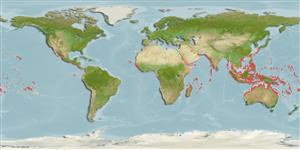>
Tetraodontiformes (Puffers and filefishes) >
Monacanthidae (Filefishes)
Etymology: Cantherhines: Greek, kanthos = the outer or inner corner of the eye, where the lids meet, 1646 + Greek, rhinos = nose (Ref. 45335).
More on author: Rüppell.
Environment: milieu / climate zone / rango de profundidad / distribution range
Ecología
marino asociado a arrecife; rango de profundidad 0 - 20 m (Ref. 9710). Tropical; 32°N - 32°S
Eastern Atlantic: Gulf of Guinea, Annobon Islands to south coast of Africa (Ref. 3592). Indo-Weat Pacific: South Africa to Red Sea (Ref. 4421) and east to southern Japan and southeastern Oceania. Replaced by Cantherhines sandwichiensis (Quoy & Gaimard 1824) in the Hawaiian Islands (Ref. 37816).
Tamaño / Peso / Age
Madurez: Lm ? range ? - ? cm
Max length : 25.0 cm TL macho / no sexado; (Ref. 3592); common length : 15.0 cm TL macho / no sexado; (Ref. 3467)
Short description
Claves de identificación | Morfología | Morfometría
Espinas dorsales (total) : 2; Radios blandos dorsales (total) : 32 - 36; Espinas anales: 0; Radios blandos anales: 29 - 32. Can adopt three basic color patterns: mottled grey and brown, dark brown, or grey with a network of close-set polygonal spots. All have a small white spot at the rear base of the second dorsal fin and sometimes the anal fin.
Body shape (shape guide): short and / or deep.
Occurs on outer reef slopes to depths of 2 to more than 20 m (Ref. 1602, 48637), often silty habitats. Young float with loose surface weeds and adults are often with large Sargassum rafts during the wet season (Ref. 48637). Solitary. Feeds on benthic organisms (Ref. 30573). Somewhat secretive (Ref. 9710). Minimum depth reported taken from Ref. 128797.
Life cycle and mating behavior
Madurez | Reproducción | Puesta | Huevos | Fecundidad | Larva
Randall, J.E., G.R. Allen and R.C. Steene, 1990. Fishes of the Great Barrier Reef and Coral Sea. University of Hawaii Press, Honolulu, Hawaii. 506 p. (Ref. 2334)
IUCN Red List Status (Ref. 130435: Version 2025-1)
Threat to humans
Harmless
Human uses
Pesquerías: escaso valor comercial
Herramientas
Special reports
Download XML
Fuentes de Internet
Estimates based on models
Preferred temperature (Referencia
123201): 24.7 - 29.3, mean 28.2 °C (based on 3455 cells).
Phylogenetic diversity index (Referencia
82804): PD
50 = 0.5002 [Uniqueness, from 0.5 = low to 2.0 = high].
Bayesian length-weight: a=0.01585 (0.00918 - 0.02736), b=2.93 (2.78 - 3.08), in cm total length, based on LWR estimates for this species & (Sub)family-body (Ref.
93245).
Nivel trófico (Referencia
69278): 3.5 ±0.37 se; based on food items.
Resiliencia (Referencia
120179): Medio, población duplicada en un tiempo mínimo de 1.4-4.4 años (Preliminary K or Fecundity.).
Fishing Vulnerability (Ref.
59153): Low vulnerability (15 of 100).
🛈
Nutrients (Ref.
124155): Calcium = 34.3 [10.0, 108.2] mg/100g; Iron = 0.832 [0.283, 2.230] mg/100g; Protein = 18.3 [16.1, 20.5] %; Omega3 = 0.0798 [, ] g/100g; Selenium = 36.1 [13.8, 97.3] μg/100g; VitaminA = 68.3 [19.9, 238.4] μg/100g; Zinc = 1.69 [0.77, 2.96] mg/100g (wet weight); based on
nutrient studies.
